| 1660 |
|
The spectacular slipware made in Staffordshire in the last 80 years
of the seventeenth century and the first 10 years of the 18th century
were large circular dishes, these were made by Thomas Toft and his
sons Thomas and James. Most platters were decorated with an intricate
design bordered with trelliswork and an inscription. The slip was
trailed and dotted on a coating of white slip. Black, brown, orange
or white slips were applied on top. A 'yellow lead glaze' was used
over the decoration. |
In
the 16th and 17th century coffee was introduced from Arabia, together
tea, coffee and chocolate were changing British drinking habits, replacing
beer as the main drink. Coffee drinking became a craze for the well-to-do
and after 1650 coffee houses opened up all over London and many other
cities and towns. |
1665
1669 |
Robert
Hooke used a microscope to study structures of natural objects and
published a book "Micrographia".
Completion of Samuel Pepys diaries.
Building of Eddystone lighhouse. |
Thomas
Toft dish, made in Staffordshire, late 17th century.
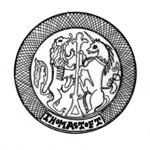
|
The
mid 17th century saw the emergence of the 'middle shot' groups of
farmers, clergymen and layers. It also saw the growth of magazines,
journals and novels. |
| 1672
|
Agate
ware jugs, mugs and other vessels made by John Dwight factory in Fulham,
1672. |
|
Coffee
Houses became important meeting places for politicians and intellectuals.
Wills Coffee House in Covent Garden was an important venue. |
| 1673 |
Rebuilding
of St Paul's Cathedral |
|
|
| 1675 |
Christopher
Wren's plans for St Paul's accepted |
|
|
| 1678 |
Popish
plans to murder Charles II |
|
The
scientific advances of the 17th century were part of the European
movement. Enlightenment grew out of he ideas across Europe. Questioning
the traditional teachings of the church and to celebrate the power
of human reasoning. Isaac Newton Science and Logic and John Locke's
ideas on social needs an influential writer on Government, Education
and his 'Essays on Human understanding' reflect the quest for knowledge. |
| 1686 |
East
India Company established in Calcutta |
|
| 1687
|
Publication
of Isaac Newton's mathematical principals of natural philosophy |
|
| 1689 |
William and Mary accept declaration of Rights and become joint monarchs |
|
| 1693 |
Some thoughts concerning Education - John Locke |
|
| 1694
|
Bank
of England set up |
|
| 1695 |
Bank of Scotland set up |
|
| 1696 |
Royal Board of Trade set up |
Slipware
cradle, c.1700
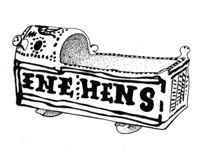
|
| 1698
|
Thomas
Savery develops the steam pump |
Tygs, (drinking
vessels with 2 or more handles)made in Staffordshire, 1701
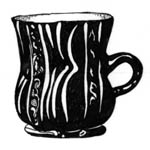 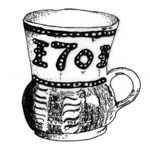
|
| 1702 |
Death of William III |
| 1705 |
Isaac Newton knighted |
Late
17th/early 18th century: Elers red ware - a fine stoneware with
a semi-vitrified body. Two brothers, John and David Elers, who had
worked in Delft and Cologne, came to England in the late 17th century
and started to work as silversmiths. They then moved to Staffordshire
to set up apottery in bradwell Wood. Their fine finish was achieved
by the introduction of the lathe for turning.
Teapot,
Elers style of red stoneware, early 18th century
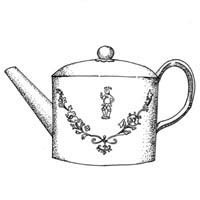
|
The
18th century:
Two revolutions occurred in Britain, the Agricultural Revolution and
the Industrial Revolution. The Agricultural Revolution saw reforms
in land management and scientific principals applied to the growing
of crops (crop rotation) and the breeding of animals (selective breeding).
|
| 1711 |
St. Pauls Cathedral completed |
| 1712
|
Thomas
Newcomen develops steam-powered engine for use in mines |
From
about 1720-1730's Aaron Wood and Sons of Big House, Burslem made
Buff-coloured stoneware decorated with raised white pipe-clay. This
was known as 'Drabware'.
Drabware teapot, c.1720-30
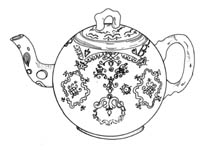
|
| 1720 |
|
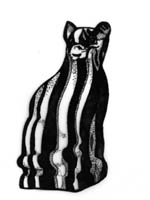
Agateware cat, c.1720
Until about 1730 pots were either thrown or press moulded. Around
this time a new method of slip casting developed allowing for finer
and more diverse shapes. Around this time, 'Pew Groups' came in,
they were made of white salt glazed stoneware with detail described
in 'brown stained' clay. |
| 1727
|
Death
of George I |
| 1728
|
Cyclopedia
published in England, it was the forerunner of the encyclopaedia |
Trade
in the 18th century brought in exotic goods, including Chinese porcelain,
teas, spices and cheap cotton from India.
|
| 1731
|
Publication
of New Horse Houghing by Jethro Tull |
| 1733
|
John
Kay develops the flying shuttle |
| 1740 |
|
Pew
Group, salt-glazed stoneware, Staffordshire, c.1730-40
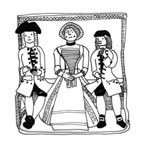
|
| 1741
|
Handel's
Messiah written |
From
about the 1740's colour was first introduced by incising a design
into the body of the clay in its leather hard stage and rubbing
cobalt clay into the scratched surface, this technique is known
as 'Scratch Blue'.
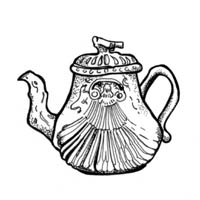
White salt-glazed tea-pot, c.1740
|
| 1742 |
Handel's Messiah performed for the first time in Dublin |
Scratch
blue mug, c.1740-64
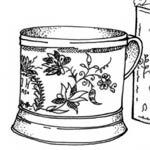
|
|
| 1749
|
'Soft
paste' factory founded in Bristol making Meissen type figures. |
Around
this time manufacturers worked with one type of glaze while experiments
were in progress to match or 'frit' different glazes to different
clay bodies around the 1740's Enoch Booth made a fine glaze from
lead powder, flint and clay which gave a good even coat when biscuit
ware was dipped into it.
|
|
| 1750
|
|
1740-1753:
Elers, Thomas Astbury, Thomas Whieldon and Enoch Booth experimented
with coloured glazes. Whieldon Ware is well known for its 'tortoiseshell
' glazes. Many makers imitated this and the name 'Whieldon' is now
a generic name describing a 'style' that was developed by Thomas
Whieldon.
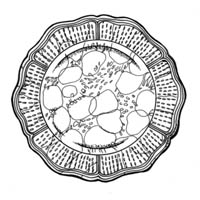
Plate by Thomas Whieldon, c.1750
|
The
industrial revolution starting around the 1760's grew from the foundations
that had been laid earlier in the century. Industrialisation with
new methods of powering machinery and the manufacturing of goods was
enabled by improvements in the road networks between towns and cities,
the building of canals and later the railway enabled greater mobility,
improved trade, larger markets and greater choice. |
| |
|
Agate
ware:
In the 1680's John Dwight of Fulham had used different clays mixed
together to imitate agate. Thomas Whieldon had also made agate ware
handles for knives sometime before 1740. By the mid 1700's aggateware
was also used with salt-glaze to make teapots and figures. The red
and white clays could be carefully constructed and cut to give very
fine patterns.
Agateware teapot, c.1745
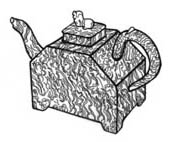
|
| 1754
|
Opening
of Sankey Brook Birth of Engineer Thomas Telford. |
1750:
New transfer on ceramics was being developed by a firm called Sadler
and Green, allowing copper plate printing to be used on china and
earthenware. This firm was later to supply Wedgwood.
1754: Thomas Weildon went into partnership with Josiah Wedgwood. Wedgwood
was to develop a fine green glaze.
1759: Josiah Wedgwood started on his won. He began making Cream coloured
earthenware and was to use the green glaze he had developed on the
cauliflower and more exotic pineapple ware. |
| 1762
|
Bridgewater
Canal from Worsley to Manchester opened |
|
| 1764
|
James
Hargreaves develops the Spinning Jenny |
1764:
Josiah Wedgwood's pottery moves to Brick House Pot Bank in Burslem.
1765: J. Wedgwood made a tea service for Queen Charlotte. This cream
coloured earthenware became known as 'Queensware'. Cream coloured
earthenware was also made in Leeds possibly as early as this but had
become lighter in appearance by 1775. A feature of the early ware
is the double twisted flat handle. |
| 1768
|
Voyage
of Captain Cooke on the Endeavour. A scientific expedition to the
Pacific Ocean. |
1769:
The opening of Etruria factory. The first factory to produce cream
coloured earthenware on a commercial scale.
1770: By now manufacture of salt glazed stoneware and delft almost
ceased, being replaced with the Cram-coloured earthenware. |
| 1773
|
Stock
Exchange founded The Literary club founded by Joshua Reynolds. Samuel
Johnson published the English Dictionary. |
|
|
| 1777 |
The Trent Mersey Canal completed. |
Wedgwood
Queensware chestnut basket, c.1773
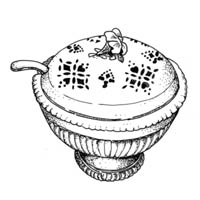
|
|
| 1783
|
James
Watt develops rotary steam engine.
George IV as Prince of Wales first visit to village of Brighthelmstone,
when it was becoming a fashionable resort fro the new pastime of sea-bathing
known now as Brighton. |
1780:
Thomas Whiedon retired. Josiah Wedgwood introduces a new white body
called 'Pearlware'. George Stubbs painted the Wedgwood family in
the grounds of Etruria Hall.
|
|
| 1789
|
Thames
and Severn canal completed. |
Teapot,
Leeds, c.1780
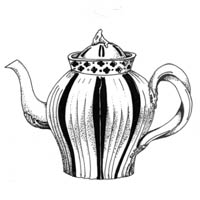
|
|
| 1790
|
|
Establishment
of the Herculaneum pottery. |
|
| 1795 |
|
Josiah
Wedgwood died. |
|














